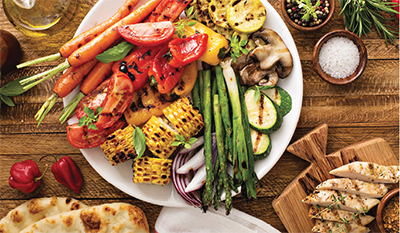MyPlate—The Vegetable Group: Vary Your Veggies
Guide E-139
Revised by Raquel Garzon
College of Agricultural, Consumer and Environmental Sciences, New Mexico State University
Author: Extension Nutrition and Wellness Specialist, Department of Extension Family and Consumer Sciences, New Mexico State University. (Print Friendly PDF)
Introduction
The vegetable group includes vegetables and 100% vegetable juices. Vegetables can be eaten raw or cooked and are available fresh, frozen, canned, or dried/dehydrated. They can be eaten whole, cut up, or mashed. Vegetables are naturally low in calories and fat, and are free of cholesterol. Vegetables are divided into five subgroups depending on their nutrient content: dark green, red and orange, dry beans and peas, starch, and other. MyPlate recommends a variety of vegetables, especially dark green and red and orange vegetables, as well as beans and peas.
Eating a diet rich in vegetables and fiber as part of a healthy diet may reduce the risk of heart disease and certain types of cancer. It can also reduce the risk of developing obesity and type 2 diabetes.

© Elena Veselova | Dreamstime.com
Nutrients in the Vegetable Group
The following nutrients are found in most vegetables. A typical American diet is at risk for being low in nutrients marked with an asterisk (*).
*Fiber helps reduce blood cholesterol levels, may reduce the risk of heart disease, and promotes proper bowel function. Fiber can also promote the existence of good bacteria in our digestive tract. Fiber-containing foods such as vegetables help provide a feeling of fullness with fewer calories. Whole, cut up, or mashed vegetables are sources of dietary fiber; vegetable juices typically contain little or no fiber.
*Folate helps produce red blood cells and reduces a woman’s risk of having a child with a brain or spinal cord defect.
*Potassium helps maintain a healthy blood pressure and is needed for muscle and nerve function. Potassium may also reduce the risk of kidney stones and bone loss.
Vitamin A aids in normal vision, keeps skin healthy, and helps protect against infections.
Vitamin C helps heal cuts and wounds, grow and repair all body tissues, and maintain healthy teeth and gums.
How Many Vegetables are Needed?
MyPlate recommends eating between 1 and 3 cups of vegetables every day, depending on your age, gender, and level of physical activity (Table 1). For more information, visit www.choosemyplate.gov.
What does 1 cup from the vegetable group mean?
- 1 cup raw or cooked vegetables
- 2 cups of raw leafy greens
- 1 cup cooked dry beans or peas
- 1 cup of 100% vegetable juice
|
Table 1. Daily Recommendations for the Vegetable Group |
||
|
Age |
Cup(s) |
|
|
Children |
2–3 years 4–8 years |
1 1 1/2 |
|
Girls |
9–13 years 14–18 years |
2 2 1/2 |
|
Boys |
9–13 years 14–18 years |
2 1/2 3 |
|
Women |
19–30 years 31–50 years 51+ years |
2 1/2 2 1/2 2 |
|
Men |
19–30 years 31–50 years 51+ years |
3 3 2 1/2 |
|
*These amounts are appropriate for people who get less than 30 minutes per day of moderate exercise; those who are more physically active may be able to eat more than what is recommended in the table. |
||
Eat a Variety of Veggies
Vary your veggies by including selections from the five vegetable subgroups. Vegetables are organized into these subgroups based on their nutrient content.
Dark green vegetables include bok choy, broccoli, collard greens, dark green leafy lettuce, kale, mustard greens, spinach, turnip greens, and watercress. Dark green leafy vegetables are low in calories and provide vitamins A and C, folate, fiber, potassium, magnesium, and calcium. MyPlate recommends that most adults eat 1 1/2 to 2 cups of dark green vegetables each week.
Red and orange vegetables include acorn squash, butternut squash, carrots, Hubbard squash, pumpkin, red bell peppers, and sweet potatoes. These vegetables are good sources of vitamin A, potassium, and fiber. MyPlate recommends that most adults eat between 4 and 6 cups of red and orange vegetables each week.
Starchy vegetables include corn, green peas, lima beans, and potatoes. Starchy vegetables are higher in calories than other vegetables. They are a source of carbohydrates and fiber. Watch your portion size of these vegetables when you include them in your meal plan. MyPlate recommends that most adults eat between 4 and 6 cups of starchy vegetables each week.
Other vegetables include artichokes, asparagus, beets, cabbage, cauliflower, celery, cucumbers, eggplant, green beans, green peppers, iceberg lettuce, jicama, mushrooms, okra, onions, tomatoes, tomato juice, wax beans, and zucchini. The vegetables in this subgroup vary in their nutrient content and have unique contributions to your diet, so eating a variety is key. MyPlate recommends that most adults eat between 3 1/2 and 5 cups of other vegetables each week.
Beans and peas include black, garbanzo, kidney, lima, navy, pinto, soy, and white beans; black-eyed peas; split peas; and lentils. Dry beans and peas are a good source of protein, fiber, minerals, and folate. MyPlate recommends that most adults eat between 1 and 2 cups of dry beans and peas each week.
Beans, peas, and legumes can be used as a vegetable or as a protein. Amounts are different for each group:
- 1/4 cup beans/peas = 1-ounce equivalent for the protein group
- 1 cup beans/peas = 1 cup vegetables
Tips for Buying Vegetables
- Buy fresh vegetables in season when they have peak flavor and are available at a good price.
- Buy vegetables that are easy to prepare, such as pre-washed bags of salad greens, grape tomatoes, or baby carrots.
- Buy frozen vegetables without added sauces.
- When you are shopping, pick your frozen vegetables last to make sure they stay frozen on your trip home. Choose frozen vegetables that are hard and not in ice. Ice on the package could indicate that the vegetables have thawed and been refrozen.

© Oksun70 | Dreamstime.com
Tips for Healthful Eating from the Vegetable Group
- Vary your vegetable choices. Vegetables differ in nutrient content.
- Stock up on frozen vegetables for quick and easy cooking.
- Plan some meals around a vegetable main dish, such as a vegetable stir-fry or vegetable soup.
- Add grated carrots or zucchini into meatloaf, spaghetti sauce, and casseroles.
- Throw some veggies on the grill—try bell peppers, onions, or zucchini.
- Substitute spiraled zucchini for pasta noodles or riced cauliflower for rice in recipes.
Keep it Safe
- Bag fresh vegetables separately from meat, poultry, and seafood products when packing them to take home from the market.
- When preparing any fresh produce, begin with clean hands. Wash your hands for 20 seconds with warm water and soap before and after preparation.
- Cut away any damaged or bruised areas on fresh vegetables before preparing and/or eating. Produce that looks rotten should be discarded.
- All produce should be thoroughly washed before eating. This includes produce grown conventionally or organically at home, as well as produce that is purchased from a grocery store or farmer’s market. Wash vegetables under running water just before eating, cutting, or cooking.
- Even if you plan to peel the produce before eating, it is still important to wash it first.
- Washing vegetables with soap or detergent or using commercial produce washes is not recommended by the USDA.
- Scrub firm produce (such as carrots or beets) with a clean produce brush.
- Keep vegetables that will be eaten raw separate from other foods, such as raw meat, poultry, or seafood, and from kitchen utensils used for those products.
“Go, Slow, Whoa” Foods
An easy way to make smart and nutritious choices within the vegetable group is to use the “Go, Slow, Whoa” concept.
- “Go” foods are the most nutrient-dense; they contain more of the nutrients you need with relatively fewer calories. Eat them almost any time, based on your calorie needs.
– Examples: all fresh, frozen, and canned vegetables without added fat or sauces
- “Slow” foods are higher in calories, fat, and/or sugar than “Go” foods. Eat them sometimes, at most several times a week.
– Examples: all vegetables with added fat or sauces; oven-baked French fries; avocado
- “Whoa” foods are high in calories, fat, and/or sugar and offer less nutritional value. Eat them only once in a while or on special occasions, and in small portions.
– Examples: fried potatoes, like French fries or hash browns; other deep-fried vegetables
To learn more about “Go, Slow, and Whoa” foods, visit https://www.nhlbi.nih.gov/health/educational/wecan/downloads/gswtips.pdf
References
National Heart, Lung, and Blood Institute. 2012. Choosing foods for your family: GO, SLOW, and WHOA foods [Online]. Available from https://www.nhlbi.nih.gov/health/educational/wecan/eat-right/choosing-foods.htm
United States Department of Agriculture. 2018. ChooseMyPlate.gov: All about the vegetable group [Online]. Available from https//www.choosemyplate.gov/vegetables
For further reading
E-140: MyPlate - The Dairy Group: Get Your Calcium-Rich Foods
https://pubs.nmsu.edu/_e/E140/
E-141: MyPlate - The Fruit Group: Focus on Fruits
https://pubs.nmsu.edu/_e/E141/
E-142: MyPlate - The Grain Group: Make At Least Half Your Grains Whole Grains
https://pubs.nmsu.edu/_e/E142/
E-143: MyPlate - The Protein Group: Go Lean With Protein
https://pubs.nmsu.edu/_e/E143/
 |
Visit ChooseMyPlate.gov for complete information on the MyPlate plan, including recipes, healthful eating tips, and tools to track your diet and exercise. |

Raquel Garzon is the Extension Nutrition and Wellness Specialist at NMSU. She has a doctorate in health science and is a Registered Dietitian. She has experience working as a clinical and community dietitian for adults and children, as well as working in the area of high-performance training for corporations and professional athletes. Her goal in Extension is to improve the well-being of New Mexicans through programs, collaborations, and education.
To find more resources for your business, home, or family, visit the College of Agricultural, Consumer and Environmental Sciences on the World Wide Web at pubs.nmsu.edu
Contents of publications may be freely reproduced, with an appropriate citation, for educational purposes. All other rights reserved. For permission to use publications for other purposes, contact pubs@nmsu.edu or the authors listed on the publication.
New Mexico State University is an equal opportunity/affirmative action employer and educator. NMSU and the U.S. Department of Agriculture cooperating.
Revised October 2018 Las Cruces, NM

